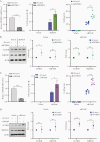Genomics Links Inflammation With Neurocognitive Impairment in Children Living With Human Immunodeficiency Virus Type-1
- PMID: 33373444
- PMCID: PMC8408770
- DOI: 10.1093/infdis/jiaa792
Genomics Links Inflammation With Neurocognitive Impairment in Children Living With Human Immunodeficiency Virus Type-1
Abstract
Background: We identified host single-nucleotide variants (SNVs) associated with neurocognitive impairment (NCI) in perinatally HIV-infected (PHIV) children.
Methods: Whole-exome sequencing (WES) was performed on 217 PHIV with cognitive score for age (CSA) < 70 and 247 CSA ≥ 70 (discovery cohort [DC]). SNVs identified in DC were evaluated in 2 validation cohorts (VC). Logistic regression was used to estimate adjusted odds ratios (ORs) for NCI. A human microglia NLRP3 inflammasome assay characterized the role of identified genes.
Results: Twenty-nine SNVs in 24 genes reaching P ≤ .002 and OR ≥ 1.5 comparing CSA < 70 to CSA ≥ 70 were identified in the DC, of which 3 SNVs were identified in VCs for further study. Combining the 3 cohorts, SNV in CCRL2 (rs3204849) was associated with decreased odds of NCI (P < .0001); RETREG1/FAM134B (rs61733811) and YWHAH (rs73884247) were associated with increased risk of NCI (P < .0001 and P < .001, respectively). Knockdown of CCRL2 led to decreased microglial release of IL-1β following exposure to ssRNA40 while knockdown of RETREG1 and YWHAH resulted in increased IL-1β release.
Conclusions: Using WES and 2 VCs, and gene silencing of microglia we identified 3 genetic variants associated with NCI and inflammation in HIV-infected children.
Keywords: 14-3-3η protein; CCRL2; HIV; HIV perinatal infection; RETREG1; YWHAH; genome-wide exome sequencing; neurocognitive impairment.
© The Author(s) 2020. Published by Oxford University Press for the Infectious Diseases Society of America. All rights reserved. For permissions, e-mail: journals.permissions@oup.com.
Figures



References
Publication types
MeSH terms
Substances
Grants and funding
LinkOut - more resources
Full Text Sources
Medical
Molecular Biology Databases
Miscellaneous

